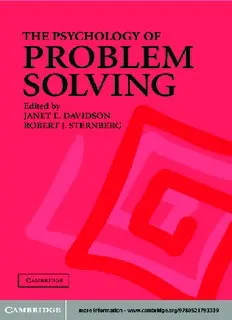Table Of Content
ThePsychologyofProblemSolving
Problems are a central part of human life. The Psychology of Problem
Solving organizes in one volume much of what psychologists know
about problem solving and the factors that contribute to its success
orfailure.Therearechaptersbyleadingexpertsinthisfield,includ-
ingMiriamBassok,RandallEngle,AndersEricsson,ArthurGraesser,
NorbertSchwarz,KeithStanovich,andBarryZimmerman.
The Psychology of Problem Solving is divided into four parts. Fol-
lowinganintroductionthatreviewsthenatureofproblemsandthe
historyandmethodsofthefield,PartIIfocusesonindividualdiffer-
encesin,andtheinfluenceof,theabilitiesandskillsthathumansbring
toproblemsituations.PartIIIexaminesmotivationalandemotional
statesandcognitivestrategiesthatinfluenceproblem-solvingperfor-
mance,whilePartIVsummarizesandintegratesthevariousviewsof
problemsolvingproposedintheprecedingchapters.
Janet E. Davidson is Associate Professor of Psychology at Lewis &
Clark College. She conducts research on several aspects of problem
solving,includingtherolesthatinsightandmetacognitiveskillsplay
inproblemsolving.
RobertJ.SternbergisIBMProfessorofPsychologyandEducationat
Yale University and Director of the Yale Center for the Psychology
of Abilities, Competencies and Expertise (PACE Center). Professor
Sternberg is Editor of Contemporary Psychology and past Editor of
PsychologicalBulletin.
Together,ProfessorsDavidsonandSternberghaveeditedtwoprevi-
ousbooks,ConceptionsofGiftedness(Cambridge,1986)andTheNature
ofInsight(1995).
The Psychology of Problem Solving
Editedby
JANET E. DAVIDSON
Lewis&ClarkCollege
ROBERT J. STERNBERG
YaleUniversity
Cambridge, New York, Melbourne, Madrid, Cape Town, Singapore, São Paulo
Cambridge University Press
The Edinburgh Building, Cambridge , United Kingdom
Published in the United States of America by Cambridge University Press, New York
www.cambridge.org
Information on this title: www.cambridge.org/9780521793339
© Cambridge University Press 2003
This book is in copyright. Subject to statutory exception and to the provision of
relevant collective licensing agreements, no reproduction of any part may take place
without the written permission of Cambridge University Press.
First published in print format 2003
-
isbn-13 978-0-511-06314-5 eBook (NetLibrary)
-
isbn-10 0-511-06314-8 eBook (NetLibrary)
-
isbn-13 978-0-521-79333-9 hardback
-
isbn-10 0-521-79333-5 hardback
isbn--13 978-0-521-79741-2 paperback
-
isbn-10 0-521-79741-1 paperback
Cambridge University Press has no responsibility for the persistence or accuracy of
s for external or third-party internet websites referred to in this book, and does not
guarantee that any content on such websites is, or will remain, accurate or appropriate.
Contents
Contributors pagevii
Preface ix
part i introduction
1 Recognizing,Defining,andRepresentingProblems 3
JeanE.Pretz,AdamJ.Naples,andRobertJ.Sternberg
2 TheAcquisitionofExpertPerformanceasProblem
Solving:ConstructionandModificationofMediating
MechanismsthroughDeliberatePractice 31
K.AndersEricsson
part ii relevant abilities and skills
3 IsSuccessorFailureatSolvingComplexProblemsRelated
toIntellectualAbility? 87
DoritWenkeandPeterA.Frensch
4 Creativity:ASourceofDifficultyinProblemSolving 127
ToddI.LubartandChristopheMouchiroud
5 InsightsaboutInsightfulProblemSolving 149
JanetE.Davidson
6 TheRoleofWorkingMemoryinProblemSolving 176
DavidZ.HambrickandRandallW.Engle
7 ComprehensionofTextinProblemSolving 207
ShannonWhittenandArthurC.Graesser
part iii states and strategies
8 MotivatingSelf-RegulatedProblemSolvers 233
BarryJ.ZimmermanandMagdaCampillo
v
vi Contents
9 FeelingandThinking:ImplicationsforProblemSolving 263
NorbertSchwarzandIanSkurnik
10 TheFundamentalComputationalBiasesofHuman
Cognition: Heuristics That (Sometimes) Impair Decision
MakingandProblemSolving 291
KeithE.Stanovich
11 AnalogicalTransferinProblemSolving 343
MiriamBassok
part iv conclusions and integration
12 ProblemSolving–Large/Small,Hard/Easy,
Conscious/Nonconscious,Problem-Space/Problem-Solver:
TheIssueofDichotomization 373
KennethKotovsky
Index 385
Contributors
MiriamBassok
UniversityofWashington
MagdaCampillo
GraduateSchoolandUniversityCenter,
CityUniversityofNewYork
JanetE.Davidson
Lewis&ClarkCollege
RandallW.Engle
GeorgiaInstituteofTechnology
K.AndersEricsson
FloridaStateUniversity
PeterA.Frensch
Humboldt-UniversityatBerlin
ArthurC.Graesser
TheUniversityofMemphis
DavidZ.Hambrick
MichiganStateUniversity
KennethKotovsky
CarnegieMellonUniversity
ToddI.Lubart
Universite´ Rene´ Descartes,Paris
ChristopheMouchiroud
Universite´ Rene´ Descartes,Paris
vii
viii Contributors
AdamJ.Naples
YaleUniversity
JeanE.Pretz
YaleUniversity
NorbertSchwarz
UniversityofMichigan
IanSkurnik
UniversityofMichigan
KeithE.Stanovich
UniversityofToronto
RobertJ.Sternberg
YaleUniversity
DoritWenke
Humboldt-UniversityatBerlin
ShannonWhitten
TheUniversityofMemphis
BarryJ.Zimmerman
GraduateSchoolandUniversityCenter,
CityUniversityofNewYork
Preface
Almost everything in life is a problem. Even when we go on vacations
toescapeourproblems,wequicklydiscoverthatvacationsmerelybring
problems that differ in kind or magnitude from the ones of daily living.
In addition, we often find that the solution to one problem becomes the
basisofthenextone.Forexample,closingonahousesolvestheproblem
ofbuyingahouse,butusuallymeanstheinitiationofawholenewsetof
problemspertainingtohomeownership.
Becauseproblemsareacentralpartofhumanlife,itisimportanttoun-
derstandthenatureofproblemsolvingandthesourcesthatcanmakeitdif-
ficult.Whenpeoplehaveproblems,howdotheyidentify,define,andsolve
them?Whenandwhydotheysucceedatproblemsolvingandwhenand
whydotheyfail?Howcanproblem-solvingperformancebeimproved?
Ourgoalforthisbookistoorganizeinonevolumewhatpsychologists
knowaboutproblemsolvingandthefactorsthatcontributetoitssuccess
or failure. To accomplish this goal, we gave each of our contributors the
followingproblem:“Useyourareaofexpertisetodeterminewhatmakes
problem solving difficult.” By examining why problem solving is often
difficultforpeople,wehopetodiscoverhowtomakeiteasierandmore
productive.However,thebook’sfocusisnotadiscouragingonethatem-
phasizesonlyfailuresinproblemsolving.Instead,itprovidesabalanced
viewofwhyproblemsareandarenotsolvedsuccessfully.Therefore,the
bookisorganizedbyfactorsthataffectproblem-solvingperformance,such
asintellectualabilities,workingmemory,motivation,andtransferoftrain-
ing,ratherthanbyareaofendeavor,suchasmathematics,socialscience,
naturalscience,andhistory.Eachchapterfocusesononeormorefactors
that are common to the solution of a wide range of problems. However,
theextenttowhichthesefactorsaffectproblem-solvingperformancecan
varyfromonetypeofproblemtoanother.
The book is divided into four parts. Part I comprises the introduction
to the book and to the field of problem solving. In chapter 1, Jean Pretz,
ix

